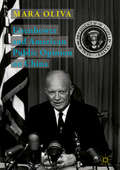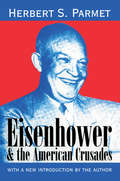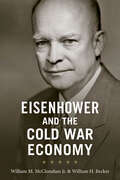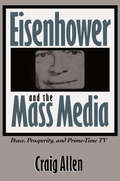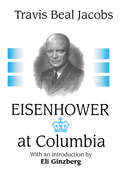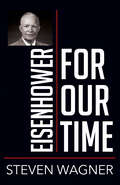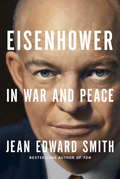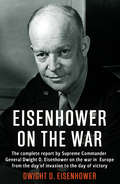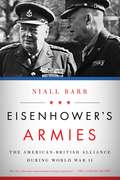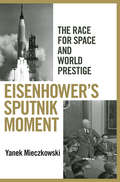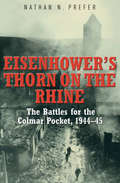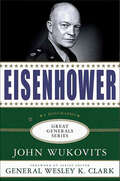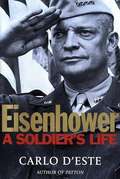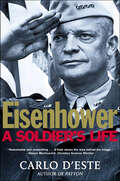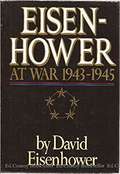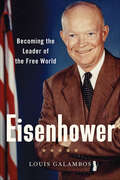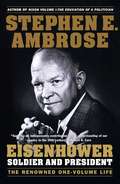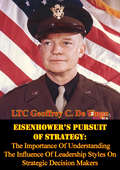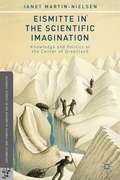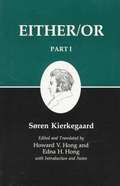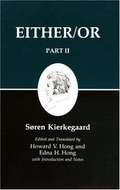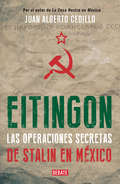- Table View
- List View
Eisenhower and American Public Opinion on China
by Mara OlivaIn the 1950s, most of the American public opposed diplomatic and trade relations with Communist China; traditional historiography blames this widespread hostility for the tensions between China and the United States during Dwight D. Eisenhower’s presidency. In this book, Mara Oliva reconsiders the influence of U.S. public opinion on Sino-American relations, arguing that it is understudied and often misinterpreted. She shows how the Eisenhower administration’s hard line policy towards Beijing had been formulated in line with U.S. national security interests, not as a result of public pressure. However, the public did play a significant role in shaping the implementation, timing and political communication of Washington’s strategy, ultimately hampering relations with the Communist giant and seriously heightening the risk of nuclear conflict. Drawing together an extensive array of published and unpublished sources, this book offers a new prism for understanding one of the most difficult decades in the history of both countries.
Eisenhower and the American Crusades
by Herbert S. ParmetHerbert S. Parmet's Eisenhower and the American Crusades is a major assessment of the American presidency during the critical period of America at mid-century. The book follows the career of General Dwight D. Eisenhower from 1952, when he decided to leave his NATO command to campaign for the presidency, to his retirement at Gettysburg nearly nine years later. His entry into politics was well-timed. A mood of conservatism was sweeping the country; surveys indicated that the majority of Americans felt it was time for a change from two decades of executive control 'by those who had permitted events to get out of hand.'Parmet based his study of the Eisenhower years on massive research, conversations with leading figures of the era, and previously unreleased documents. This wealth of material has enabled him to provide answers to questions frequently asked about the thirty-fourth president: Was Eisenhower the kind, fatherly man millions grew up to love on their television or was this an image created by a shrewd politician who knew what the country needed in a trying time?Did he choose Richard Nixon as a running mate or was Nixon forced upon him by political necessities? Was the president intimidated by the appearance of power of Joseph McCarthy, and did the Army-McCarthy hearings influence Eisenhower's decision to involve the United States in Vietnam? Was Eisenhower concerned with the lack of progress in civil rights? Was he the right man for the right time in history or was he merely postponing the major crises of the 1960s?Parmet offers a convincing refutation of the idea of the Eisenhower years as being placid or boring. 'No years that contained McCarthy and McCarthyism, a war in Korea, constant fears of nuclear annihilation, and spreading racial violence, could be so described.' For Parmet, Eisenhower was a stabilizing force in a time of conflict. He may not have been a political genius, but he knew perhaps better than anyone else around him exactly what the people wanted and how they wanted it.
Eisenhower and the Cold War Economy
by William M. McClenahan Jr. William H. BeckerThroughout his two-term presidency, Dwight D. Eisenhower faced the challenge of managing a period of peacetime prosperity after more than two decades of depression, war, and postwar inflation. The essential issue he addressed was how the country would pay for the deepening Cold War and the extent to which such unprecedented peacetime commitments would affect the United States economy and its institutions. William M. McClenahan, Jr., and William H. Becker explain how Eisenhower’s beliefs and his experiences as a military bureaucrat and wartime and postwar commander shaped his economic policies. They explore the macro- and microeconomic policies his administration employed to finance the Cold War while adapting Republican ideas and Eisenhower's economic principles to new domestic and foreign policy environments. They also detail how Eisenhower worked with new instruments of government policy making, such as the Council of Economic Advisers and a strengthened Federal Reserve Board. In assessing his administration's policies, the authors demonstrate that, rather than focusing overwhelmingly on international political affairs at the expense of economic issues, Eisenhower’s policies aimed to preserve and enhance the performance of the American free market system, which he believed was inextricably linked to the successful prosecution of the Cold War. While some of the decisions Eisenhower made did not follow conservative doctrine as closely as many in the Republican Party wanted, this book asserts that his approach to and distrust of partisan politics led to success on many fronts and indeed maintained and buttressed the nation's domestic and international economic health. An important and original contribution, this examination of the Eisenhower administration's economic policy enriches our understanding of the history of the modern American economy, the presidency, and conservatism in the United States.
Eisenhower and the Mass Media: Peace, Prosperity, and Prime-time TV
by Craig AllenA UNC Press Enduring Edition -- UNC Press Enduring Editions use the latest in digital technology to make available again books from our distinguished backlist that were previously out of print. These editions are published unaltered from the original, and are presented in affordable paperback formats, bringing readers both historical and cultural value.
Eisenhower at Columbia
by Travis JacobsFirst Published in 2018. Routledge is an imprint of Taylor & Francis, an Informa company.
Eisenhower for Our Time (People for Our Time)
by Steven WagnerEisenhower for Our Time provides an introduction to the Eisenhower presidency, extracting lessons for today's world. Steven Wagner proposes that the need to maintain balance defines Eisenhower's presidency. Wagner examines a series of defining moments that were among Eisenhower's greatest challenges, some of which resulted in his greatest accomplishments: the decision to run for president, his political philosophy of the "Middle Way," the creation of a national security policy, the French Indochina War, Senator Joseph McCarthy, the Little Rock Desegregation Crisis, the Race for Space, and the famous Farewell Address. Wagner looks at Eisenhower's executive ability, leadership, decision making, and willingness to compromise, as well as the qualities of duty, integrity, and good character. The moments detailed in Eisenhower for Our Time show Eisenhower as a president intimately engaged in the decisions that defined America in his time and that apply to ours today. The President's actions place him among the most successful presidents and provide many lessons to guide us in our time and in the future.
Eisenhower in War and Peace
by Jean Edward SmithIn his magisterial bestseller FDR, Jean Edward Smith gave us a fresh, modern look at one of the most indelible figures in American history. Now this peerless biographer returns with a new life of Dwight D. Eisenhower that is as full, rich, and revealing as anything ever written about America's thirty-fourth president. As America searches for new heroes to lead it out of its present-day predicaments, Jean Edward Smith's achievement lies in reintroducing us to a hero from the past whose virtues have become clouded in the mists of history. Here is Eisenhower the young dreamer, charting a course from Abilene, Kansas, to West Point, to Paris under Pershing, and beyond. Drawing on a wealth of untapped primary sources, Smith provides new insight into Ike's maddening apprenticeship under Douglas MacArthur in Washington and the Philippines. Then the whole panorama of World War II unfolds, with Eisenhower's superlative generalship forging the Allied path to victory through multiple reversals of fortune in North Africa and Italy, culminating in the triumphant invasion of Normandy. Smith also gives us an intriguing examination of Ike's finances, details his wartime affair with Kay Summersby, and reveals the inside story of the 1952 Republican convention that catapulted him to the White House.Smith's chronicle of Eisenhower's presidential years is as compelling as it is comprehensive. Derided by his detractors as a somnambulant caretaker, Eisenhower emerges in Smith's perceptive retelling as both a canny politician and a skillful, decisive leader. Smith convincingly portrays an Eisenhower who engineered an end to America's three-year no-win war in Korea, resisted calls for preventative wars against the Soviet Union and China, and boldly deployed the Seventh Fleet to protect Formosa from invasion. This Eisenhower, Smith shows us, stared down Khrushchev over Berlin and forced the withdrawal of British, French, and Israeli forces from the Suez Canal. He managed not only to keep the peace--after Ike made peace in Korea, not one American soldier was killed in action during his tenure--but also to enhance America's prestige in the Middle East and throughout the world.Domestically, Eisenhower reduced defense spending, balanced the budget, constructed the interstate highway system, and provided social security coverage for millions who were self-employed. Ike believed that traditional American values encompassed change and progress.Unmatched in insight, Eisenhower in War and Peace at last gives us an Eisenhower for our time--and for the ages.From the Hardcover edition.
Eisenhower on the War: The Complete Report By The Supreme Commander On The War In Europe
by Dwight D. EisenhowerFirst published in 1946 as Eisenhower’s Own Story of the WarTHIS is one of the truly great documents in the history of human conflict. It is the personal, yet definitive report of the world’s mightiest military operation, written by the one man qualified to write it, the man under whose Supreme Command the Allied forces rode to triumph. A classic of information, in the plain language for which our Chief of Staff is famous, it reveals the whole inside story of how the war was run and won.
Eisenhower vs. Warren: The Battle For Civil Rights And Liberties
by James F. SimonThe epic 1950s battle that would shape the legal future of the civil rights movement is chronicled here for the first time. The bitter feud between President Dwight D. Eisenhower and Chief Justice Earl Warren framed the tumultuous future of the modern civil rights movement. Eisenhower was a gradualist who wanted to coax white Americans in the South into eventually accepting integration, while Warren, author of the Supreme Court’s historic unanimous opinion in Brown v. Board of Education, demanded immediate action to dismantle the segregation of the public school system. In Eisenhower vs. Warren, two-time New York Times Notable Book author James F. Simon examines the years of strife between them that led Eisenhower to say that his biggest mistake as president was appointing that “dumb son of a bitch Earl Warren.” This momentous, poisonous relationship is presented here at last in one volume. Compellingly written, Eisenhower vs. Warren brings to vivid life the clash that continues to reverberate in political and constitutional debates today.
Eisenhower's Armies: The American-British Alliance during World War II
by Niall BarrAn authoritative and dramatic behind-the-scenes history of 'the Atlantic Alliance' during World War II. The Anglo-American relationship from 1941-1945 proved to be the most effective military alliance in history. Yet there were also constant tensions and disagreements that threatened to pull the alliance apart. This book highlights why the unprecedented level of cooperation between the very different American and British forces eventually led to victory but also emphasizes the tensions and controversies which inevitably arose. Based on considerable archival research on both sides of the Atlantic, this work considers the breadth and depth of the relationship from high-level strategic decisions, the rivalries and personalities of the commanders to the ordinary British and American soldiers who fought alongside one another. The book also looks back and demonstrates how the legacy of previous experience shaped the decisions of the war. Eisenhower's Armies is the story of two very different armies learning to live, work, and fight together even in the face of serious strategic disagreements. The book is also a very human story about the efforts of many individuals—famous or otherwise—who worked and argued together to defeat Hitler’s Germany. In highlighting the cooperation, tensions, and disagreements inherent in this military alliance, this work shows that Allied victory was far from pre-ordained and proves that the business of making this alliance work was vital for eventual success. Thus this dynamic new history provides a fresh perspective on many of the controversies and critical strategic decisions of World War II. As such, this book provides expert analysis of the Anglo-American military alliance as well as new insights into the ‘special relationship’ of the mid-twentieth century.
Eisenhower's Sputnik Moment: The Race for Space and World Prestige
by Yanek MieczkowskiIn a critical Cold War moment, Dwight D. Eisenhower's presidency suddenly changed when the Soviet Union launched Sputnik, the world's first satellite. What Ike called "a small ball" became a source of Russian pride and propaganda, and it wounded him politically, as critics charged that he responded sluggishly to the challenge of space exploration. Yet Eisenhower refused to panic after Sputnik-and he did more than just stay calm. He helped to guide the United States into the Space Age, even though Americans have given greater credit to John F. Kennedy for that achievement.In Eisenhower's Sputnik Moment, Yanek Mieczkowski examines the early history of America's space program, reassessing Eisenhower's leadership. He details how Eisenhower approved breakthrough satellites, supported a new civilian space agency, signed a landmark science education law, and fostered improved relations with scientists. These feats made Eisenhower's post-Sputnik years not the flop that critics alleged but a time of remarkable progress, even as he endured the setbacks of recession, medical illness, and a humiliating first U.S. attempt to launch a satellite. Eisenhower's principled stands enabled him to resist intense pressure to boost federal spending, and he instead pursued his priorities-a balanced budget, prosperous economy, and sturdy national defense. Yet Sputnik also altered the world's power dynamics, sweeping Eisenhower in directions that were new, even alien, to him, and he misjudged the importance of space in the Cold War's "prestige race." By contrast, Kennedy capitalized on the issue in the 1960 election, and after taking office he urged a manned mission to the moon, leaving Eisenhower to grumble over the young president's aggressive approach.Offering a fast-paced account of this Cold War episode, Mieczkowski demonstrates that Eisenhower built an impressive record in space and on earth, all the while offering warnings about America's stature and strengths that still hold true today.
Eisenhower's Thorn on the Rhine: The Battles for the Colmar Pocket, 1944–45
by Nathan N. Prefer&“The difficult fighting in the Colmar Pocket is brought to vivid life&” in this WWII chronicle of the Allied 6th Army Group (WWII History). By the fall of 1944, the Western Allied forces appeared to be unstoppable. The summer&’s Normandy invasion had driven the Germans out of northern France and most of the Low Countries. In September, they liberated France&’s southern coast with little opposition. Then, Allied divisions began lining up along the Rhine. While the Americans met a nasty surprise in the Ardennes, the Germans also held on to the province of Alsace, maintaining a hard pocket around the city of Colmar. On New Year&’s Eve, they launched Operation Northwind, a counteroffensive that nearly put Allied forces back on their heels. On January 12, 1945, Eisenhower could only tell George Marshall that Colmar was &“a very bad thorn in our side today.&” This is the story of the Sixth Army Group, a unit that combined US and French forces, and its unexpectedly bloody and protracted battle for the Colmar Pocket. Amidst a horrific winter and rough terrain, interspersed by demolished towns, the Allied Army Group traded blows with the German 19th in a ferocious campaign. This book informs us fully of the tremendous and costly struggle waged in an often-neglected sector of World War II&’s European Theater.
Eisenhower: A Biography (Great Generals Series)
by John Wukovits“A concise portrayal of the commander who served as the chief architect of D-Day.” —Col. Cole C. Kingseed, New York Times–bestselling coauthor of Beyond Band of BrothersAmerican general and thirty-fourth US president Dwight D. Eisenhower was the principal architect of the successful Allied invasion of Europe during World War II, and the subsequent defeat of Nazi Germany. In this biography, military historian John Wukovits explores Eisenhower’s contributions to American warfare. Eisenhower led the assault on the French coast at Normandy and held together the Allied units through the European campaign that followed. The book reveals Eisenhower’s advocacy in the pre-war years of the tank, his friendships with George Patton and Fox Conner, his service in the Philippines with Douglas MacArthur, and his culminating role as supreme commander of Allied forces in Europe.With an introduction by General Wesley Clark, Eisenhower skillfully demonstrates how Dwight Eisenhower’s evolution as a commander, his military doctrine, and his diplomatic skills are of extreme importance in understanding modern warfare.“A portrait of a general who devised and sustained a broad-front strategy that led to Germany’s unconditional surrender, and a man who never took his eyes off the prize.” —The Star-Ledger
Eisenhower: A Soldier's Life
by Carlo D'EsteFrom the bestselling author of Patton: A Genius for War comes a compelling new account of the transformation of General Dwight D. Eisenhower, from apprehensive soldier to one of our greatest heros. In the weeks leading up to D-Day, Dwight D. Eisenhower seethed with nervous energy. He had not expected his military career to bring him to this moment. The son of pacifists, Ike graduated from high school more likely to teach history than to make it. Casting new light on this profound evolution, Eisenhower chronicles the unlikely, dramatic rise of the supreme Allied commander. Beginning with the lasting effect of Eisenhower's impoverished youth, bestselling biographer Carlo D'Este follows his subject through West Point and a sometimes troubled marriage; toil under MacArthur in the Philippines during the 1930s; the inner sanctums of the War Department; the general's painful North African apprenticeship; and, finally, the dramatic events leading to the Allied victory in May 1945. Exposing for the first time numerous myths that have surrounded the war hero and his family (such as his romance with his wartime driver, Kay Summersby), D'Este also probes Eisenhower's famous clashes with his American peers and the British chiefs of staff, as well as his relations with legendary figures, including Winston Churchill and George S. Patton. Unlike other biographies of the general, Eisenhower captures Ike's true character, from his youth to the pinnacle of his career and afterward.
Eisenhower: A Soldier's Life
by Carlo D'EsteThe acclaimed biographer presents an intimate and comprehensive portrait of the legendary president and WWII general: “An excellent book.” —The Washington Post Book WorldBorn into hardscrabble poverty in rural Kansas, the son of stern pacifists, Dwight David Eisenhower graduated from high school more likely to teach history than to make it. Yet he went on to become one of America’s most important military leaders. Then, on the wings of victory, the career soldier ascended to the nation’s highest political office. Casting new light on this profound evolution, Carlo D’Este chronicles the unlikely, dramatic rise of the supreme Allied commander.With full access to private papers and letters, D’Este has exposed for the first time the countless myths that have surrounded Eisenhower and his family for over fifty years. In this revealing biography, he identifies the complex and contradictory character behind Ike’s famous grin and air of calm self-assurance.
Eisenhower: At War 1943-1945
by David EisenhowerThe first volume of a multi-volume study of President Eisenhower, this book focuses on Eisenhower's conduct of the war and provides an extensively documented analysis of the political ramifications of the course of the war and Eisenhower's decisions
Eisenhower: Becoming the Leader of the Free World (The\papers Of Dwight David Eisenhower Ser.)
by Louis Galambos"Highly accessible and sprightly written."—Library JournalWinner of the Kansas State Library's Kansas Notable Book AwardIn this engaging, fast-paced biography, Louis Galambos follows the career of Dwight D. "Ike" Eisenhower, offering new insight into this singular man who guided America toward consensus at home and a peaceful victory in the Cold War.The longtime editor of the Eisenhower papers, Galambos may know more about this president than anyone alive. In this compelling book, he explores the shifts in Eisenhower's identity and reputation over his lifetime and explains how he developed his distinctive leadership skills. As a career military officer, Eisenhower's progress was uneven. Galambos shows how Ike, with the help of Brigadier General Fox Conner, his mentor and patron, learned how to profit from his mistakes, pivot quickly, and grow as a military and civilian leader. On D-Day, Eisenhower guided the largest amphibious force in history to a successful invasion of France and a decisive victory. After the defeat of Nazi Germany, he turned to politics and was elected president in 1952.While today's fiercely partisan political climate makes it difficult to imagine a president forging consensus in Washington, that's exactly what Eisenhower did. As America's leader in an era of profound postwar changes at home and abroad, President Eisenhower sought a middle way with compromise and coalition building. He provided his country with firm-handed leadership, bringing prosperity and peace to the American people in the dangerous years of the Cold War—an accomplishment that made him one of the most influential men of the twentieth century. Destined to be the best short biography of the thirty-fourth president of the United States, Eisenhower conclusively demonstrates how and why this master of the middle way became the successful leader of the free world.
Eisenhower: Soldier and President (Eisenhower Center Studies On War And Peace)
by Stephen E. AmbroseStephen E. Ambrose draws upon extensive sources, an unprecedented degree of scholarship, and numerous interviews with Eisenhower himself to offer the fullest, richest, most objective rendering yet of the soldier who became president. He gives us a masterly account of the European war theater and Eisenhower's magnificent leadership as Allied Supreme Commander. Ambrose's recounting of Eisenhower's presidency, the first of the Cold War, brings to life a man and a country struggling with issues as diverse as civil rights, atomic weapons, communism, and a new global role. Along the way, Ambrose follows the 34th President's relations with the people closest to him, most of all Mamie, his son John, and Kay Summersby, as well as Franklin D. Roosevelt, Winston Churchill, Charles de Gaulle, Harry Truman, Nixon, Dulles, Khrushchev, Joe McCarthy, and indeed, all the American and world leaders of his time. This superb interpretation of Eisenhower's life confirms Stephen Ambrose's position as one of our finest historians.
Eisenhower’s Gettysburg Farm (Images of America)
by Michael J. Birkner Carol A. Lavery Foreword By EisenhowerThe Eisenhower farm was the first and only home that Dwight Eisenhower and his wife, Mamie, called their own. During Eisenhower’s military career, he and Mamie lived around the world, but he always hoped to own a piece of property and leave it better than he found it. That wish led to the purchase of the Allen Redding farm in 1950 and the Eisenhowers’ thorough renovation of its dwelling. During Eisenhower’s presidency, the farm served as a retreat from the Washington pressure cooker. When his presidential term ended, the Eisenhowers embraced a new chapter in their lives together. Eisenhower maintained an active schedule of writing, speechmaking, correspondence, and meetings with a wide range of national and world leaders, as well as supervision of an active farm operation. Mamie and Dwight shared a busy social life in retirement, taking special pleasure in spending time with their son John, daughter-in-law Barbara, and four grandchildren. This book tells the Eisenhowers’ Gettysburg story.
Eisenhower’s Pursuit Of Strategy: The Importance Of Understanding The Influence Of Leadership Styles On Strategic Decision Makers
by LTC Geoffrey C. De TingoEisenhower preferred to build consensus for his military and national strategies by using multiple communication techniques to convey his intent. If consensus was not achieved, though, and his intent was not carried out he would aggressively move to eliminate the source of friction. This monograph will analyze four case studies to demonstrate that it is critically important for subordinates and peers to understand the influence of leadership styles on strategic decision makers. It will also argue that the consequences for not understanding strategic decision makers can mean the difference between individual, organizational or national success or failure.The four case studies will highlight the leadership styles that Eisenhower used when he pursued a strategy and how those leadership styles influenced his decision-making. The first case study is Eisenhower's fight to control Allied strategic bombers to support Operation Overlord in 1944. Second is his fight to develop, implement and defend his New Look National Security Strategy in 1953. Third is how Eisenhower defended his administration's Middle East foreign policy and finally his strategy to seek a peaceful solution to the Suez Canal Crisis of 1956.
Eisenhower’s Six Great Decisions: Europe, 1944–1945
by General Walter Bedell SmithEisenhower's Chief of Staff reviews the six turning points of the European war that took the Allies from Normandy to the heart of Germany in only 11 months.War, as in life, turns on decisions taken and opportunities taken; the decisions of General Eisenhower as supreme commander of the Allied effort in Europe shaped the lives of millions of soldiers and tens of millions of civilians. The strain of these decisions was shared with many of the top allied commanders, but few will have understood Eisenhower's thought processes than his trusted friend, confidante and chief of staff General Walter Bedell "Beetle" Smith. A shrewd and intelligent man in his own right, the "Beetle" would be constantly by Eisenhower's side as he directed the huge Allied armies against the Wehrmacht across France, Belgium, Holland and finally into Germany itself. He set out to describe the events through the eyes of his friend and superior as they appeared at the time; the six 'Great Decisions' that he decided on as the turning points of the conduct of the war were:1 - The Decision Of The Timing Of Operation Overlord [The Normandy Landings]2 - How To Break Out Of Normandy Bocage3 - How To Deal With The Ardennes Counteroffensive [Battle Of The Bulge]4 - How To Destroy Or Capture All German Forces Against The West Of The Rhine5 - How To Encircle The Industrial Heartland Of Germany - The Ruhr.6 - How To End The War.A must read for anyone interested in the Second World War.
Eismitte In The Scientific Imagination
by Janet Martin-NielsenSince the 18th century, Greenland's geometric center, Eismitte, has been one of the most forbidding but scientifically rich locations in the Arctic. Tracing its history from European contact through the Cold War, this study shows how Eismitte was the setting for scientific knowledge production as well as diplomatic maneuvering.
Either / Or, Part I
by Howard V. Hong Edna H. Hong Søren KierkegaardIn Either/Or, using the voices of two characters - the aesthetic young man of part one, called simply 'A', and the ethical Judge Vilhelm of the second section - Kierkegaard reflects upon the search for a meaningful existence, contemplating subjects as diverse as Mozart, drama, boredom, and, in the famous Seducer's Diary, the cynical seduction and ultimate rejection of a young, beautiful woman. A masterpiece of duality, Either/Or is a brilliant exploration of the conflict between the aesthetic and the ethical - both meditating ironically and seductively upon Epicurean pleasures, and eloquently expounding the noble virtues of a morally upstanding life.
Either / Or, Part II
by Howard V. Hong Edna H. Hong Søren KierkegaardIn Either/Or, using the voices of two characters - the aesthetic young man of part one, called simply 'A', and the ethical Judge Vilhelm of the second section - Kierkegaard reflects upon the search for a meaningful existence, contemplating subjects as diverse as Mozart, drama, boredom, and, in the famous Seducer's Diary, the cynical seduction and ultimate rejection of a young, beautiful woman.
Eitingon, las operaciones secretas de Stalin en México
by Juan Alberto CedilloLa misión más importante en la vida de Leónidas Eitingon surgió bajo las órdenes de Stalin: eliminar a su peor enemigo, León Trotsky, exiliado en la ciudad de México desde 1937.Tras fallar un primer intento coordinado con David Alfaro Siqueiros, en una segunda ocasión Eitingon mezcló los peligrosos movimientos de la denominada Operación Pato con su pasatiempo favorito: conquistar bellas mujeres. Finalmente, el 20 de agosto de 1940, el ideólogo más importante de la revolución bolchevique fue asesinado. Ramón Mercader, hijo de la amante y cómplice del emblemático agente, fue el encargado de concluir la misión.A partir de documentos desclasificados del Archivo Nacional de Seguridad estadounidense, Juan Alberto Cedillo -autor de Los nazis en México- nos ofrece una fascinante trama digna de una novela de espías, aderezada con intrigas y pugnas de alto calibre.Situada durante los años cuarenta, la historia pone al descubierto las maquinaciones orquestadas por los servicios secretos soviéticos en México para matar al principal opositor al régimen, rescatar de la cárcel al homicida y espiar los trabajos científicos de construcción de la bomba atómica.
